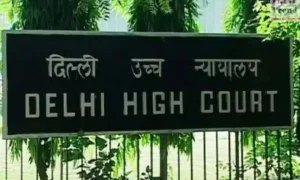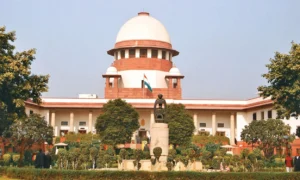
By Shailesh Gandhi
India’s judicial system, often lauded for its robust institutions and intellect, has paradoxically become an area of constant deterioration over the past 75 years, marked by escalating backlogs and an inability to deliver timely justice. While other public services like health, roads, communication, and public transport have seen improvements, the judicial delivery system stands out for its decline. This stagnation has led to a widespread acceptance of delays within the legal profession and judiciary, epitomised by the saying: “Hurried Justice is Buried Justice”, with some even jokingly suggesting cases must “mature like whisky”. However, a closer look reveals that this deeply entrenched issue is not an intractable problem, but one with a surprisingly simple and achievable solution: filling existing judicial vacancies and a modest increase in judicial strength.
THE PERVASIVE PROBLEM OF PENDENCY
The scale of judicial pendency in India is staggering, with over 50 million cases currently awaiting resolution. A study by the Ministry of Finance highlighted the severity of the situation, finding that it takes, on average, almost 20 years to resolve a property-related dispute. This contrasts sharply with European courts, where the average time for resolution is about six months, compared to India’s average of 30 months. Such delays profoundly impact the rule of law, with India’s current rule of law index standing at 79.
Beyond statistics, the delays manifest in systemic failures, particularly concerning corruption cases involving the powerful and rich. These individuals often possess the means to expedite or delay cases at will, leading to situations where cases drag on indefinitely, frequently until the accused dies. In other instances, the prolonged delays facilitate the destruction of evidence or the management of witnesses, effectively denying justice. A study of the Central Bureau of Investigation’s anti-corruption branch from 1980 to 1984, analysed in 2008, revealed deeply concerning trends: investigations averaged 13.4 months, but the first trial took an average of 88 months. Of the 144 persons convicted, all filed appeals, and by 2008, 71 cases were still ongoing, with only four individuals having served more than 20 days in prison. This systemic lethargy in investigation and judicial processes provides ample time for evidence to be destroyed, hindering efforts to constrict corruption. Major terrorist events like the Mumbai bomb blasts and Malegaon bomb blasts resulted in zero convictions after over a decade.
UNDERSTANDING THE CORE OF THE ISSUE: VACANCIES, NOT SANCTIONED STRENGTH
For years, the Supreme Court has repeatedly advocated for a judicial strength of 50 judges per million population. Currently, India’s sanctioned strength is approximately 18 judges per million, but the actual working strength is even lower, at about 14 judges per million. The total sanctioned strength stands at about 25,000 judges, yet approximately 5,000 of these positions remain unfilled.
Former Chief Justice of India Justice DY Chandrachud, in a November 2022 interview, identified filling these unfilled posts across all levels of the judiciary—from district courts to High Courts and the Supreme Court—as a critical priority. He rightly understood that addressing these vacancies is paramount to resolving judicial backlogs, but undertook no effort towards this.
An in-depth analysis of data from the Supreme Court website, spanning 2006 to 2017, sheds light on the impact of these vacancies. The study by this writer examined the number of cases instituted and the number of judges sanctioned and employed in Subordinate Courts, High Courts, and the Supreme Court. It revealed an average vacancy rate of 21 percent in Subordinate Courts, 32 percent in High Courts, and 11 percent in the Supreme Court. We then estimated how many additional cases could have been disposed of if these vacancies had been filled, using the average disposal rate per judge each year.
A SIMPLE, ACHIEVABLE SOLUTION
The findings of this analysis were counter-intuitive to the prevailing belief that a massive increase in judicial numbers is needed. The data showed that the average increase in backlog over the 12-year period was less than three percent annually. Crucially, if the existing vacancies had been filled, there would have been no backlog; instead, pendency would have decreased each year, potentially eliminating any serious backlog within six to eight years. This methodology, based on the rate of disposal, aligns with the approach taken by the 245th report of the Law Commission, headed by Justice AP Shah. Furthermore, Sanjeev Sanyal, Principal Economic Adviser to the Government of India, has stated that only an additional 2,400 judges would be required to ensure no increase in judicial pendency. The consistency in annual case disposals per judge across different court levels, indicated by low standard deviations (six percent for subordinate courts, eight percent for High Courts, 11 percent for Supreme Court), affirms the reliability of this estimation method.
The long-held notion that India needs 50 judges per million population suggests a daunting 250 percent increase in judicial staff and infrastructure, making the problem appear insurmountable. However, logical and disciplined analysis indicates that an increase of only about 20 percent in judicial strength is sufficient to resolve the issue of unacceptable delays. This modest increase would entail an extra cost of approximately 20 percent, which is easily manageable given that the current state and central expenditure on the justice system is less than one percent of total expenditure; it could readily be increased to about 1.2 percent. Should infrastructure costs and time pose challenges, Justice NV Dhabolkar’s proposal of having about 5,000 courts work in two shifts offers a viable alternative.
This proposed solution is remarkably simple, requiring no major structural changes or complex reforms.
LESSONS FROM ABROAD: A WAKE-UP CALL FROM PAKISTAN
India’s judicial inertia becomes even more stark when contrasted with other nations. While India struggles to address the Panama Papers revelations, in which 500 Indians were named for alleged illegal and corrupt actions with little visible progress, Pakistan’s judiciary acted decisively. In Pakistan, despite often being rated poorly on many counts, the judiciary declared Prime Minister Nawaz Sharif guilty of corruption and disqualified him from holding office based on evidence from the Panama Papers. In India, although the Enforcement Directorate initiated investigations and served notices to 41 individuals, and the Income Tax Department investigated 400 (with 200 confessing to offshore interests), investigations are still ongoing.
This comparison serves as a potent wake-up call for India. Despite having numerous excellent institutions, great intellectual capital, and a vibrant democracy, India has accepted a criminal justice system that cannot deliver justice in a time-bound manner. The ability of a nation’s judiciary to sentence even its top leader, as seen in Pakistan, underscores the critical role of a swift judicial system in genuinely constricting corruption and upholding the rule of law.
A FAST JUDICIAL SYSTEM: A NECESSITY FOR NATIONAL DEVELOPMENT
It is a sobering thought that Pakistan may be demonstrably better than India in this crucial area, but it also highlights that a fast criminal justice system is a necessary condition for national development. The delays in India’s judicial system are not due to a lack of capability, but rather “abject carelessness” and a lack of focus on filling vacancies. India has approximately 22,000 sanctioned judges, yet typically keeps about 5,000 positions vacant.
Implementing a fast judicial delivery system, primarily by ensuring zero vacancies in the judicial system, is easily achievable and would bring about true rule of law. India possesses the capability to do better with just a little care; what is truly needed is the display of adequate will. The path to making judicial backlogs history is clear and within reach. By focusing on filling vacancies and committing to a modest 20 percent increase in judicial strength, India can ensure a time-bound justice system, bolstering the rule of law and fostering national development.
—The writer is former Central Information Commissioner
📰 Crime Today News is proudly sponsored by DRYFRUIT & CO – A Brand by eFabby Global LLC
Design & Developed by Yes Mom Hosting





